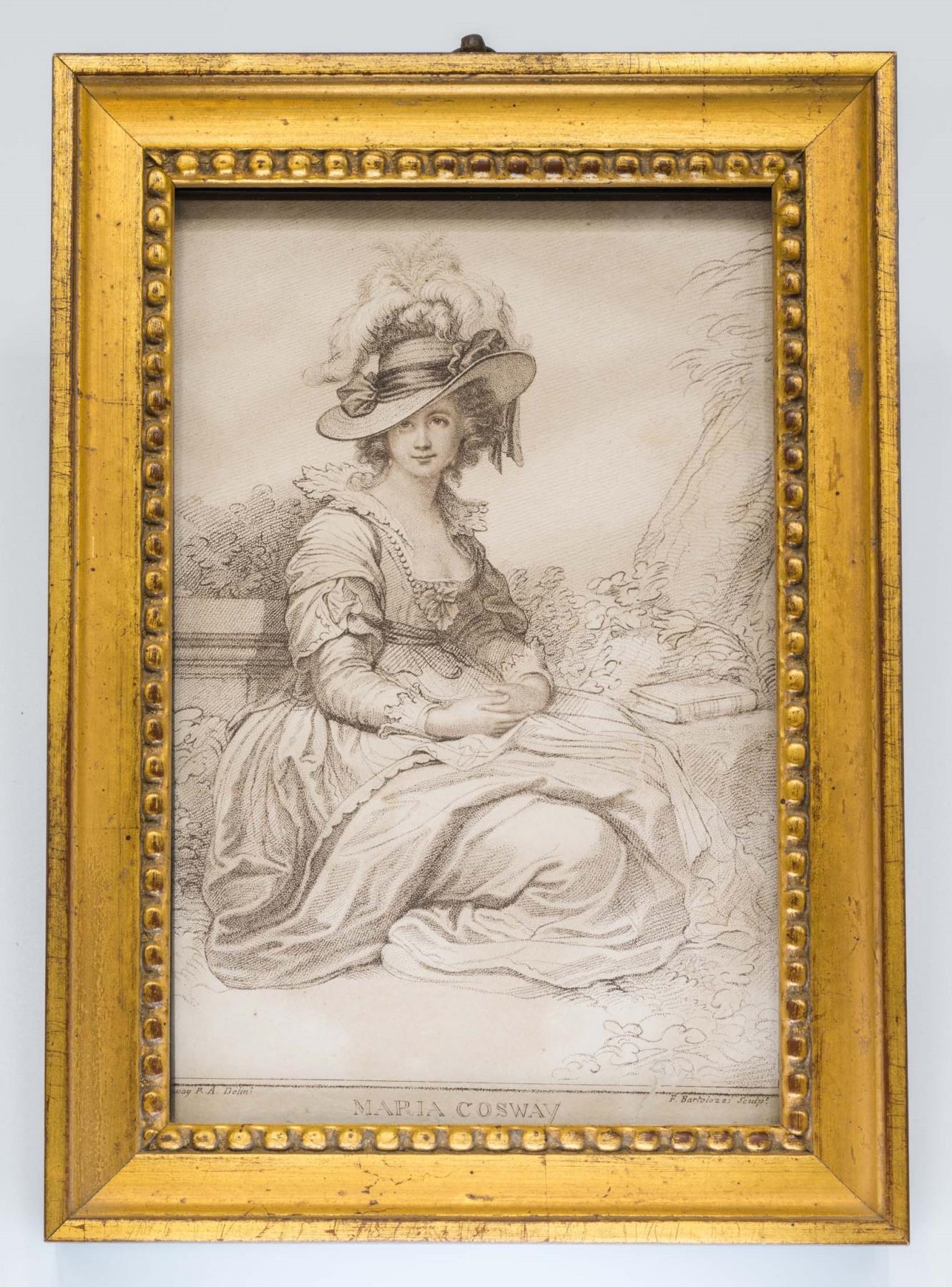Maria Cosway
Maria Hadfield Cosway, an artist and musician, was part of Thomas Jefferson's intimate circle of friends during his time in France. Jefferson described her as having "qualities and accomplishments, belonging to her sex, which might form a chapter apart for her: such as music, modesty, beauty, and that softness of disposition which is the ornament of her sex and charm of ours."[1] Her knowledge of art and immense popularity in Paris and London no doubt contributed to Jefferson's fondness for Mrs. Cosway's companionship.
Maria Hadfield was born of English parents in Italy, where she spent her youth and was schooled in drawing, music, and languages. She furthered her study of drawing in Florence and Rome, and was elected to the Academy of Fine Arts in Florence at nineteen. Maria met her mentor Angelica Kauffmann when she returned to England after her father's death, and her circle of English friends included Francesco Bartolozzi, the engraver of this portrait.
Kauffmann introduced Maria to her future husband Richard Cosway, a member of the Royal Academy who was famous for his portrait miniatures of London's aristocracy, including the royal family. Cosway was also a collector and connoisseur of Old Master paintings and drawings, prints, sculpture, and decorative art, and his duties as principal painter to the Prince of Wales included overseeing the royal collection. The Cosways frequently hosted members of London's literary and artistic circles at fashionable salons, or musical evenings, at Schomberg House in Pall Mall, which was filled with their eclectic collection.[2]
Thomas Jefferson met the Cosways in August 1786 at the Halle aux Bleds in Paris, through a connection with the American artist John Trumbull. According to Trumbull, the entourage "was occupied with the same industry in examining whatever relates to the arts .... Mr. Jefferson joined our party almost daily."[3] Their excursions included sites such as Versailles, the Louvre, Louis XIV's retreat Marly, the Palais Royal, St. Germain, and the Column at the Désert de Retz. Jefferson was enchanted by Maria, and her departure from Paris in October 1786 compelled him to write the only existing love letter in the vast collection of his correspondence, "The dialogue between my Head and my Heart," dated October 12th and 13th, 1786.[4] The bulk of the letter is a dialogue between Jefferson’s calculating reason (for which he is well known) and his spontaneous emotions (for which he is lesser known).
Giving vent to the sadness in his heart after the departure of a woman whose attributes set her "a chapter apart," Jefferson refers to himself as "the most wretched of all earthly beings." Responding to his head’s admonishment for allowing himself to become emotionally attached to Cosway, his heart defends itself as the guardian of morality and relational solace, in that "assuredly nobody will care for him who cares for nobody." However, Jefferson’s head voices the perspective that "the art of life is the art of avoiding pain," and that effective security against such pain "is to retire within ourselves, and to suffice for our own happiness."[5]
Though her husband’s extramarital affairs were no secret, Cosway was still a married woman. This fact, combined with dwindling encounters and perhaps an unknown event, contributed to a cooling of Jefferson’s interest. Thomas Jefferson returned to America in 1789, and Maria Cosway eventually moved to Lodi, Italy, and established a convent school for girls. Cosway and Jefferson wrote one another occasionally, with letters coming first from Cosway. At her home in Lodi, Cosway possessed a portrait of Jefferson by John Trumbull that is now at the White House, presented by the Italian government on the occasion of the 1976 Bicentennial.
Mrs. Cosway exhibited forty-two works at the Royal Academy between 1781 and 1801 but complained that, because her husband would not permit her to rank professionally, she lost the drawing skills from her early Italian training. Mrs. Cosway and Jefferson corresponded intermittently following their time in Paris until a year before Jefferson's death. Her letters told of the birth and short life of her only child, Angelica, and her founding of a girl's convent school in Lodi, Italy, where she died in 1838.
- Text from Stein, Worlds, 176-77
References
- ^ Jefferson to Cosway, October 12, 1786, in PTJ, 10:446. Transcription available at Founders Online.
- ^ Daphne Foskett, Dictionary of British Miniature Painters (New York: Praeger Publishers, 1972), 1:220; Stephen Lloyd, "Richard Cosway, R.A.: The Artist as Collector, Connoisseur and Virtuoso," Apollo 133 (June 1991): 398-405.
- ^ John Trumbull, The Autobiography, Reminiscences and Letters of John Trumbull (New York: Wiley and Putnam, 1841), 118.
- ^ Jefferson to Cosway, October 12, 1786, in PTJ, 10:443-55. Transcription available at Founders Online.
- ^ Ibid.
